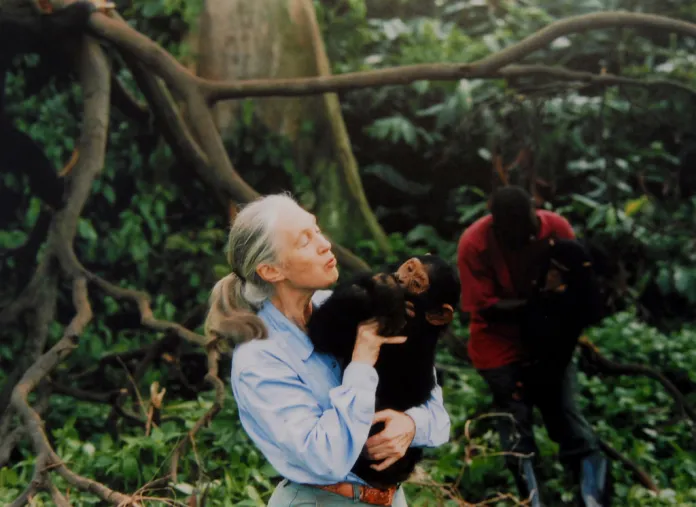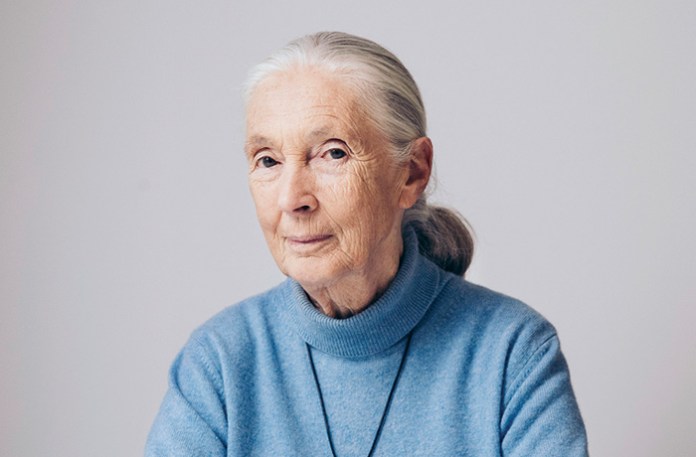In the steamy tangle of Tanzania‘s Gombe Stream National Park, a young Englishwoman once crouched for hours, banana in hand, willing herself invisible. It was 1960, and Jane Goodall — 26 years old and with no degree, just a stubborn dream sparked by a childhood of Tarzan of the Apes — upended science with a single observation: Chimps don’t just eat termites. They fish for them, wielding twig tools with paws that suddenly seemed kin to our own. That moment, caught in grainy National Geographic footage, didn’t just reveal tool use, it redrew the line between beast and human. Goodall, who died Oct. 1 at 91 while on a speaking tour in California, spent six decades blurring that line, turning a solitary stakeout into a global crusade that reshaped how we see our simian cousins and ourselves.
Born Valerie Jane Morris-Goodall on April 3, 1934, in London, she grew up in Bournemouth, where the wild tugged at her like a tide. Her mother, a novelist, fed her feral fascinations, encouraging her to sketch birds and bugs with a naturalist’s eye. At 18, Goodall ditched secretarial school for waitressing, modeling, and film editing, all to fund a boat to Africa. By 23, she was in Kenya, typing for a school friend and soon assisting paleoanthropologist Louis Leakey, whose human evolution theories hinged on primates as living clues. Leakey saw in Goodall a rare blend of grit and empathy and sent her to Gombe, a rainforest sliver on Lake Tanganyika’s shore.
This was no mere safari. Goodall hauled supplies up steep trails, slept in a tent amid leopards and scorpions, and endured months of chimp indifference until David Greybeard, a silver-backed elder, approached with a pant-hoot like a truce. Her notebook filled with scandal: Chimps hugged, grieved, and waged brutal territorial skirmishes, with alliances shifting over figs and grudges. At Cambridge, where Leakey insisted she earn a PhD, Goodall’s 1965 thesis raised eyebrows. Naming her subjects — Fifi, Flo, Figan — instead of numbering them implied that chimps had personalities, a scientific heresy. “We were studying individuals,” she said, her quiet defiance a hallmark of her career. Critics scoffed, but the public ate it up. Her 1963 book My Friends, the Wild Chimpanzees sold briskly, and a 1965 NBC special, Miss Goodall and the World of Chimpanzees, made her khaki-clad figure a household name.

Goodall’s observations deepened, revealing tool use as routine — chimps cracking nuts with stones like stonemasons — and matriarchal lineages passing skills like recipes. She noted that adolescents test boundaries with reckless bravado, with eerily human squabbles over status. But Gombe’s idyll darkened in the 1970s with poaching and habitat loss. A 1975 kidnapping of researchers by rebels forced a pivot: Science alone wouldn’t save chimps. It needed advocates. In 1977, Goodall founded the Jane Goodall Institute, focusing on community-driven conservation. Empowering Tanzanian villagers with beekeeping, microloans, and ecotourism, she proved that saving apes meant protecting people too. “You can’t save the forest without the people in it,” she avowed at a 1986 conference that marked her shift to activism. She testified before Congress, lobbied the United Nations, and often logged as many as 300 days a year on the road, her slight frame belying a rhetorical sledgehammer.
By the 1990s, Goodall targeted youth, launching Roots & Shoots in 1991 with a dozen Tanzanian teenagers on her Dar es Salaam porch. It grew to 150,000 groups across 160 countries. Children in the program planted mangroves, rescued strays, and protested plastic. Her talks, laced with tales of chimp tantrums and human hubris, captivated audiences from Tokyo to Tulsa. She championed biodiversity, linking chimp survival to global ecosystems and urging action on climate change and deforestation. “The least I can do is speak for those who cannot,” she’d say, channeling Dr. Seuss’s The Lorax. Honors stacked up: Dame Commander in 2003, U.N. Messenger of Peace in 2002, the Kyoto Prize, and, in 2025, the Presidential Medal of Freedom. A 2017 documentary, Jane, and a 2022 Barbie in field gear cemented her icon status. Critics sniped at her unscientific flair, alleging that she blended data with anecdote, but she shrugged: “If it gets the message across, who cares about footnotes?” With her 32 books and her frequent TV appearances, Goodall was for primatology what Carl Sagan was for astronomy — a scientist who was able to convey the wonders of her field to mass audiences and who inspired generations who followed her to become scientists themselves.
At 90, Goodall was still hiking Gombe’s trails, notebook in hand, fueled by tea and optimism. Jane Goodall illuminated one of the uncomfortable truths of the human condition: We’re more animalistic than we may like to admit, but at the same time, animals are more humanistic than we may realize. Still, though, her optimism about us humans never diminished, even in the age of nuclear proliferation and political turmoil. One of her final books, fittingly, was titled The Book of Hope: A Survival Guide for Trying Times. In an era of despair, she still insisted, as she once said, that “what you do makes a difference, and you have to decide what kind of difference you want to make.”
Daniel Ross Goodman is a Washington Examiner contributing writer, the author of three books, and the Allen and Joan Bildner Visiting Scholar at Rutgers University.
, 2025-10-10 04:01:00,  , Washington Examiner, %%https://www.washingtonexaminer.com/wp-content/uploads/2023/11/cropped-favicon.png?w=32, https://www.washingtonexaminer.com/feed/, Daniel Ross Goodman
, Washington Examiner, %%https://www.washingtonexaminer.com/wp-content/uploads/2023/11/cropped-favicon.png?w=32, https://www.washingtonexaminer.com/feed/, Daniel Ross Goodman
